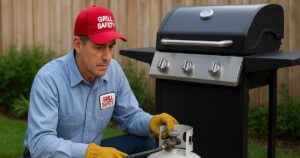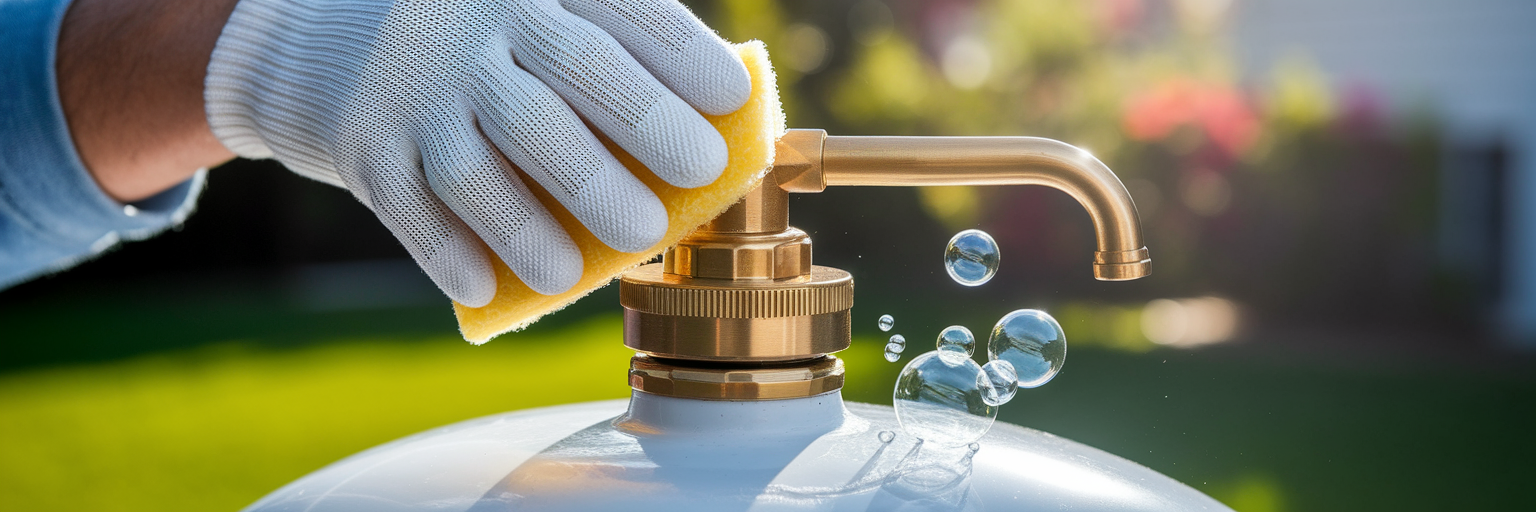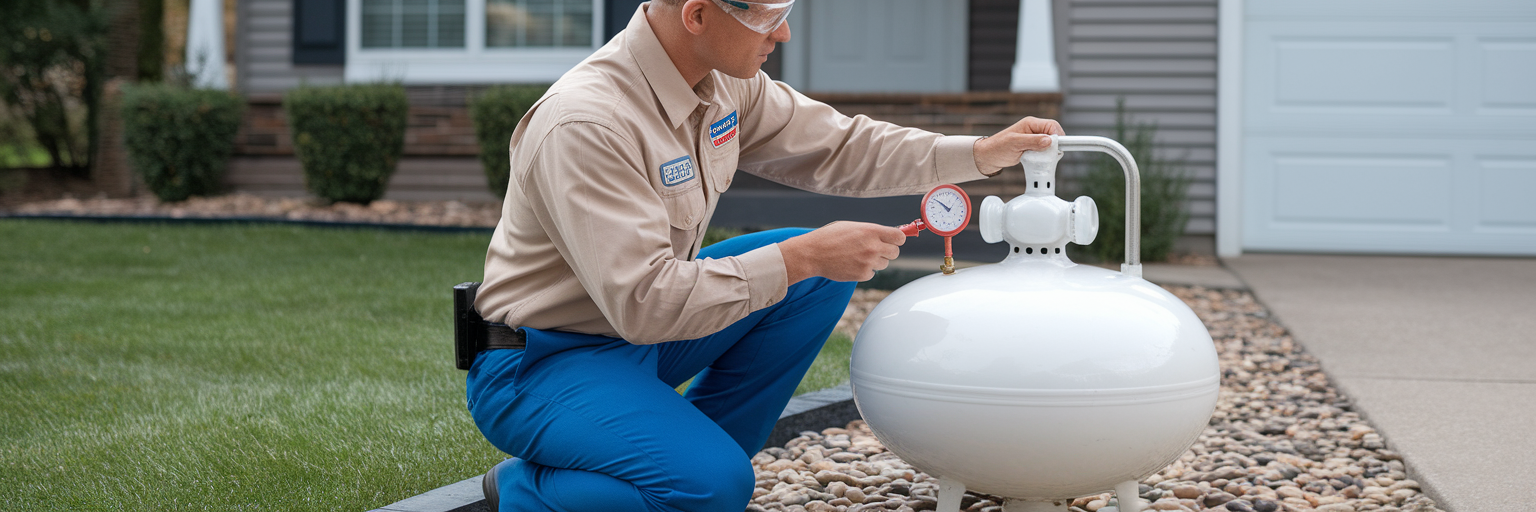
For millions of American households, propane is the quiet workhorse providing warmth, hot water, and cooked meals. Because it’s such an integral part of daily life, maintaining its source, the propane tank, is a fundamental responsibility. This isn’t about adding another chore to your list; it’s about ensuring your family’s safety and protecting your budget. Neglect carries two distinct risks: the immediate danger of a gas leak and the slow financial drain from fuel lost to corrosion or a faulty seal.
Effective residential propane tank maintenance involves a partnership between you and your supplier. While homeowners can and should perform regular visual checks, certain tasks must be left to certified professionals. Understanding this distinction is the first step toward a safe and efficient system. Proactive care is the most reliable way to ensure your home remains secure, and you can learn more about the comprehensive propane safety protocols we follow to protect our customers.
Your Routine Visual Inspection Checklist
A few minutes spent on a visual inspection can prevent significant problems down the road. Think of it like walking around your car before a long trip; you’re looking for anything out of the ordinary. This simple propane tank inspection checklist will guide you through what to look for. Remember, this is just a visual assessment. We will cover cleaning and leak testing in the next section.
- Examine the Tank Surface: Look for any deep scratches, noticeable dents, or gouges on the tank’s body. While a minor scratch in the paint is usually cosmetic, a significant impact could compromise the tank’s structural integrity.
- Assess for Corrosion: A little surface rust is often manageable, but you should watch for severe, flaking rust or pitting. These are signs that the metal is weakening. This is especially important in regions with high humidity or heavy snowfall, where moisture is a constant presence.
- Check for Stability: Your tank should rest on a solid, level foundation, typically a concrete pad. Check that its support legs are firm and not sinking into the ground. An unstable tank puts unnecessary stress on its valves and connections.
- Clear the Surrounding Area: Maintain at least a 10-foot clearance around your tank. Remove any flammable materials like dry leaves, firewood, or overgrown grass. This space not only prevents fire hazards but also improves air circulation, which helps reduce moisture buildup and corrosion.
Essential Cleaning and Leak Detection
Beyond just looking at your tank, a little hands-on care goes a long way. Keeping your tank clean helps protect its coating and makes it easier to spot potential issues. Use a simple solution of mild soap and water with a soft brush or cloth to gently wash the surface. It’s important to avoid pressure washers or abrasive chemicals, as they can strip the tank’s protective paint, leaving it vulnerable to rust.
The most critical hands-on task is to check propane tank for leaks. You can do this yourself with a simple soap bubble test. Mix a 50/50 solution of dish soap and water and apply it with a sponge or spray bottle to the tank’s valves, fittings, and connections. If you see bubbles forming, it indicates a propane leak. This is a clear signal to act immediately.
If you find a leak, first turn off the service valve on the tank by turning the handwheel clockwise, but only if it is safe to do so. Then, leave the area immediately and move a safe distance away from the tank. Do not use your phone or any electronics nearby. Once you are safely away, call your propane supplier for emergency service. Performing this check in the spring and before winter is a great habit to adopt.
Understanding Gauges and Safety Valves
Knowing your tank’s components helps you monitor its performance without attempting dangerous adjustments. The most visible part is the float gauge, which shows the fuel level as a percentage. It’s wise to call for a refill when the gauge reads between 20% and 30% to avoid an unexpected runout. Another critical component is the safety relief valve. This valve automatically vents pressure if it gets too high, and it must never be blocked, painted, or tampered with.
You will also see a fill valve, used by professionals for refills, and a service valve, which controls the flow of propane to your home. The service valve is the only part a homeowner should ever operate, and only in an emergency. Familiarizing yourself with these parts is one of the most effective propane tank safety tips. If you notice a stuck gauge, hear a persistent hissing sound, or see visible frost on a valve, call a professional immediately. These are signs of a faulty component. The table below summarizes your role for each part. For more details on equipment, you can explore the systems used for our residential propane services.
| Component | Function | Homeowner’s Role |
|---|---|---|
| Float Gauge | Shows the percentage of propane remaining in the tank. | Monitor regularly; order a refill at 20-30%. |
| Safety Relief Valve | Automatically vents excess pressure to prevent rupture. | Do Not Touch. Keep clear and unpainted. |
| Service Valve | Controls the flow of propane from the tank to the house. | Turn off (clockwise) ONLY in an emergency or if a leak is suspected. |
| Fill Valve | Used by the propane professional to refill the tank. | Do Not Touch. For professional use only. |
When to Call a Certified Professional
Your role in tank maintenance is that of a vigilant observer. The visual checks and basic cleaning you perform are important, but they are not a substitute for professional service. A certified technician performs tasks that go far beyond a simple inspection. During a professional visit, they will test the regulator pressure to ensure a steady and safe flow of propane to your appliances, inspect the integrity of internal valves, and verify that your entire system complies with current safety codes.
This level of service is why it’s so important to use technicians certified by organizations like the National Propane Gas Association (NPGA). Their expertise provides a layer of safety and peace of mind that a visual check alone cannot. So, how to maintain a propane tank for the long term? The answer is a combination of your routine checks and scheduled professional service. We recommend a professional inspection every one to two years, or immediately if you discover any major issues like significant rust, a suspected leak, or a malfunctioning gauge. This is a small investment in the safety and reliability of your home’s energy system.
Modern Approaches to Tank Monitoring
Technology now offers a convenient way to supplement your maintenance routine. Remote tank monitoring systems are devices that attach to your tank’s gauge and automatically track your fuel levels. These smart monitors provide significant peace of mind by eliminating the need for manual gauge checks, especially during bad weather. They can send low-fuel alerts directly to your smartphone, helping prevent the inconvenience of a runout and allowing for more efficient delivery scheduling.
However, it is critical to understand that this technology is an enhancement for convenience, not a replacement for physical safety inspections. While a monitor tells you how much fuel you have, it cannot tell you if your tank has developed rust or if a fitting has become loose. The visual inspections, leak tests, and professional servicing detailed earlier remain absolutely essential for ensuring your tank’s physical integrity and safe operation. You can always explore more tips and topics on our blog to stay informed.
About Jennifer Whitaker
Propane industry expert and content contributor for MyPropane.com.
View all posts by Jennifer Whitaker →Related Articles

Getting Your Propane System Ready for Winter
Oct 4, 2025 • 7 min read
Learn the essential steps to prepare your home's propane system for cold weather, ensuring safety and reliability.

Safe Use of Propane Grills and BBQs: Essential Safety Guide
Sep 17, 2025 • 9 min read
Learn essential propane grill safety tips, proper setup procedures, leak detection, and maintenance guidelines to keep your family safe while…

